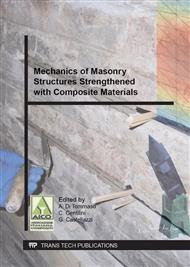p.354
p.363
p.371
p.379
p.389
p.397
p.405
p.413
p.421
Recent Developments in F.E. Analysis of FRP Reinforced Masonry Vaults: Case Studies in Italy
Abstract:
Aim of the present paper is the analysis of a series of existing masonry cross vaults exhibiting meaningful structural deterioration and diffused crack patterns, by means of an advanced non-linear and limit analysis software. The approach utilized is a non-standard and non-commercial one and bases both for the non-linear and limit analysis procedure on a FE discretization of the domain by means of rigid infinitely resistant wedges, where all the non-linearity is concentrated on interfaces between adjoining elements [1-3]. When dealing with the non-linear code, a sequential quadratic programming scheme is used at each iteration in order to deal with the deterioration of mechanical properties of interfaces, provided that the actual non-linear behavior is approximated by means of a linear piecewise constant function. Some real case studies of historic buildings in Italy are discussed. The first case study is represented by the structural analysis of a series of existing masonry cross vaults constituting the roof system of the ground floor of the former Caserma Lorenzini (ex Convent of S. Lorenzo) in Lucca, Italy, at the moment subjected to a wide restoration intervention within the so called Piuss project. The second is represented by the cross vaults of a 12th century masonry sighting tower damaged by the 20th may 2012 Emilia earthquake. This medieval tower, called Torre Fornasini, is located in the municipality of Poggio Renatico, about 10 km from Ferrara.
Info:
Periodical:
Pages:
389-396
Citation:
Online since:
September 2014
Authors:
Keywords:
Price:
Сopyright:
© 2015 Trans Tech Publications Ltd. All Rights Reserved
Share:
Citation:


